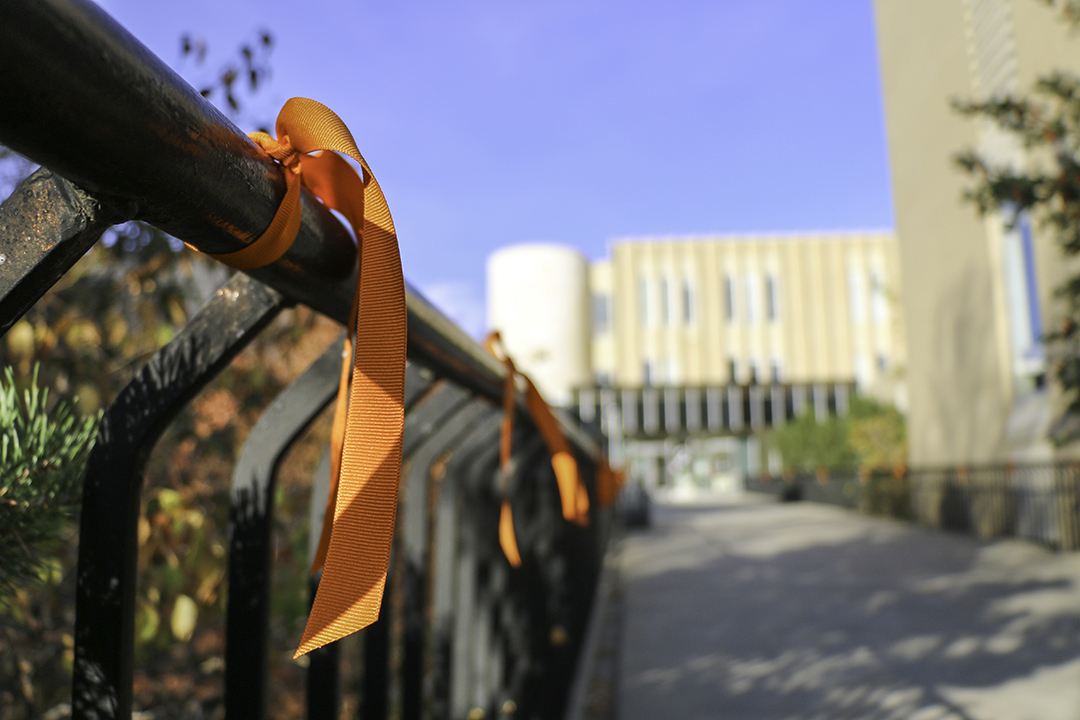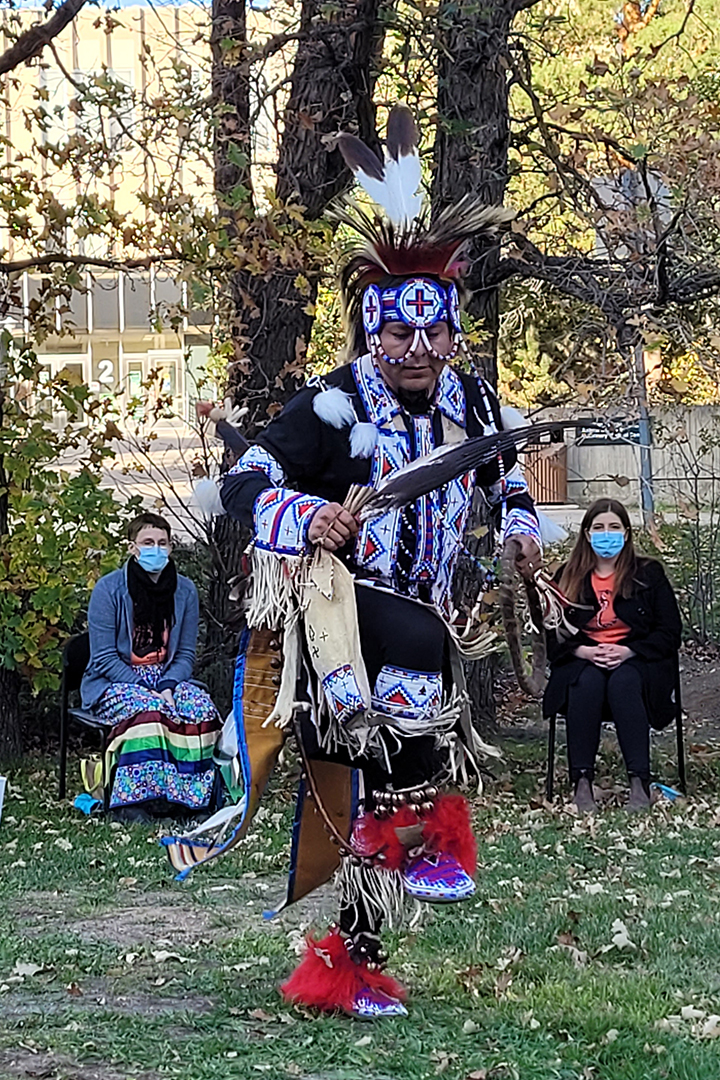
Advancing Truth and Reconciliation at the WCVM
The University of Saskatchewan’s campus-wide events on Sept. 30 marking Canada’s first National Day for Truth and Reconciliation inspired veterinary student Charlie Wyatt-Swain to plan an event at her own college.
By Jeanette Neufeld
Content warning: residential schools.
The third-year student organized an opportunity for members of the Western College of Veterinary Medicine (WCVM) community to demonstrate their allyship toward Indigenous people and commitment to the Truth and Reconciliation process.
In early October, about 40 people gathered in front of the veterinary college with Elder Mary Lee, dancer TJ Warren and singer Gordon Wasteste for a blessing and smudge.
Participants then tied orange ribbons on the guard rails along the college’s outdoor entrance ramp. The fluttering ribbons serve as a reminder of the importance of reconciliation with Canada’s Indigenous people. They also represent an expression of grief for Canada’s residential school history and the ongoing search for thousands of unmarked graves at the sites of former residential schools across Canada.
Warren, a cultural knowledge keeper from the Navajo Nation of Arizona, says his participation demonstrated the presence and importance of Indigenous people in educational institutions.
“To be witnessed by other people — that’s important so that they can see that we are still here,” says Warren. “Many times when we aren’t visible, when we aren’t seen, we are forgotten.”
He believes that a paradigm shift is occurring in education, which involves giving space to the land’s original inhabitants and allowing them to lead and share their knowledge.
Wyatt-Swain is from the NunatuKavut community in Labrador. While her own traditions differ from those shared during the event, she wanted to help the college community engage in some understanding of the cultural traditions of Indigenous people in Treaty Six territory and the Métis homeland where the WCVM is located.
“Elders are really important to all Indigenous communities, so inviting an elder to attend and lead us into the ceremony with a blessing and a prayer was really special,” says Wyatt-Swain, Indigenous student representative in the Western Canadian Veterinary Students’ Association (WCVSA). The WCVSA supported the event together with the WCVM’s Committee for Indigenous Engagement. She’s also co-club president and founder of WCVM Diverse, a student group that advocates for increased inclusivity and diversity within the college and veterinary profession.
During the smudge, participants were gifted tobacco and asked to place it mindfully on the ground before tying their orange ribbons. Warren assisted Lee with the smudge while Wasteste, who is from the Sioux Valley Dakota Nation in Manitoba, performed a prayer song to honour the unmarked graves found at the former residential school sites across Canada.
The smudge involves burning a sacred or medicinal plant and passing the smoke over the body. Warren explains that its purpose is to enter the ceremony with a clear mind, clear heart and good intentions.
“It’s to make sure everyone cleanses themselves, surround themselves with well-being and good thoughts for the task at hand,” he says.
Following the ribbon tying, participants gathered to enjoy traditional drumming and singing by Wasteste and a dance by Warren.
“Dancing is a prayer,” says Warren, who grew up travelling to and performing at powwows. “It’s a way of staying active and healthy, practising well-being and having a connection to a spiritual access point.”
Warren is an artist and an educator in Saskatoon who is married to a Cree woman from Saskatchewan. During the WCVM event, he performed a prairie chicken dance — a style of social dance that originated among the Blackfoot Confederacy and is performed at powwows and for public audiences. Warren also dances as part of his spiritual practice, but this is not displayed publicly.
Warren performs internationally and volunteers to organize powwow events in Western Canada. Despite powwow dance being outlawed for many years by the Canadian government, Indigenous people have continued to uphold the practice. This is part of why Warren performs, educates and shares the tradition with his own daughters.
“It’s a way of honouring what our ancestors have left for us,” he says.
Jessica Jackson, a third-year veterinary student and president of the WCVSA, participated in the event. While growing up in New Zealand, she learned about the island’s Indigenous Māori people. She was eager to learn more about Saskatchewan’s Indigenous traditions and to engage in an act of reconciliation.
“As an immigrant, the event was powerful and I appreciated the opportunity to watch traditional dances and songs while also learning the origin of the dance,” says Jackson.
“Walking into school the next morning [and] seeing the orange ribbons was a strong reminder of the Calls to Action and the importance of our actions moving forward.”
While some may think veterinarians and researchers at the WCVM only work with animals, Wyatt-Swain says it’s important to think of the entire community that veterinary professionals serve.
“Every pet has an owner — as veterinarians we’re going to be working with a diverse group of clients and coworkers. I think this is a good form of diversity training and awareness,” says Wyatt-Swain.
She encourages WCVM community members to participate in future college events organized through the WCVM Committee on Indigenous Engagement.
“It’s just nice for you to show up and show your support. These events come from a safe space, nobody is going to be judging you if you don’t know how to smudge, for example.”
She adds that some participants contacted her to ask how they could be better allies to Indigenous people. Attending events is a good step and encourages people to learn more, says Wyatt-Swain.
“Knowing the history of the area you’re in, knowing the history of the Indigenous people and the trauma and discrimination they’ve faced for generations is important. I think it’s important for anybody living in Canada right now,” she says.
“I hope that those who attended felt more connected to Indigenous culture, and it inspired them to continue to work toward truth and reconciliation. It was great to see the dean of the college (Dr. Gillian Muir) so involved and ready to help in any way as well, so I hope that will motivate others in the college to get involved.”
Learning opportunities at the WCVM include the “Four Seasons of Reconciliation course,” which is facilitated by Dr. Jordan Woodsworth, chair of the college’s Committee for Indigenous Engagement.
The USask Office of the Vice-Provost Indigenous Engagement works to meet the needs of Indigenous students, employees and communities and to advance the goals of reconciliation and decolonization. As well, Indigenous wellness resources are available on campus, in the community and online.
